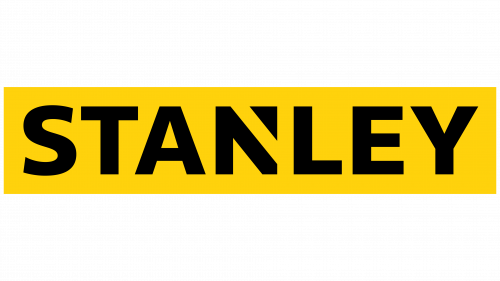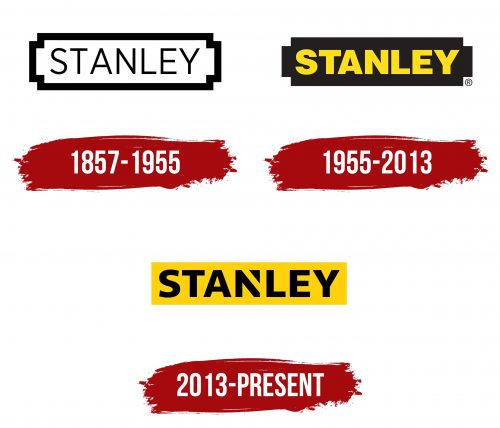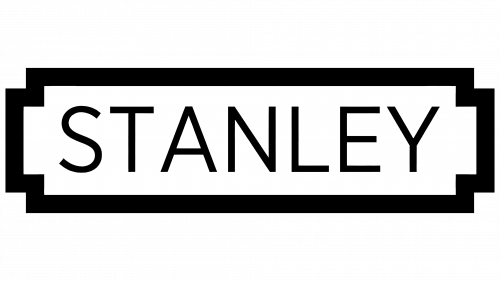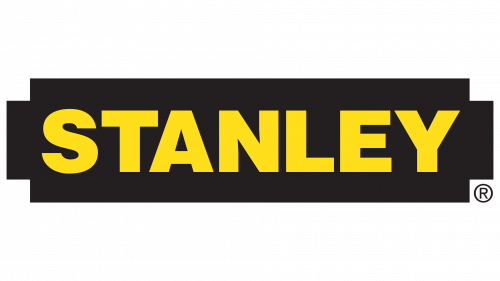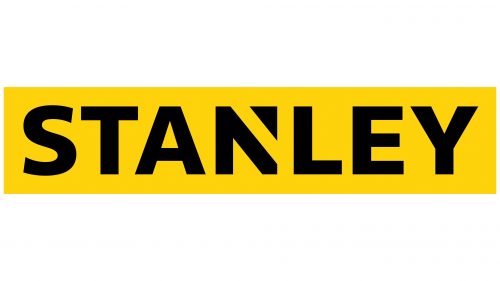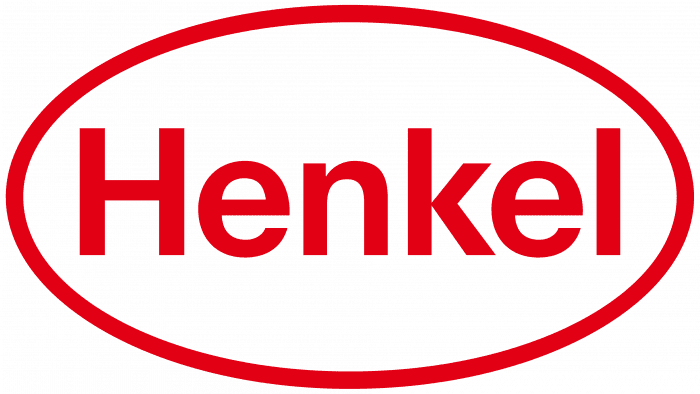The Stanley logo is businesslike, practical, and serious, fitting for a company that produces hand tools. The emblem is authoritative and characterized by minimalism, which is supported by the high quality of its products and the manufacturer’s craftsmanship.
Stanley: Brand overview
In 1843, brothers Frederick T. and William Stanley established a modest manufacturing facility known as Stanley’s Bolt Manufactory in New Britain, Connecticut, USA, marking the beginning of Stanley’s history. At first, the company’s primary focus was on manufacturing hardware products, like door bolts. The USA was going through an industrial boom then, and there was a big need for high-quality hardware and tools.
Stanley Works was the new corporate name given to the business when it was reformed in 1857. This adjustment allowed them to increase investment and production. Around this time, the business started to broaden its product line to include a variety of tools for carpenters and other craftspeople.
An important turning point in the company’s life occurred in 1869. The business obtained a patent for Leonard Bailey’s invention, the Bailey plane. These planes were revolutionary for their time because of their unique design, which made changing the cut’s depth simple. With this acquisition, the firm established itself as a top producer of hand tools.
In the 1870s, the brand increased its range of measuring instruments, including rulers and tape. Because of their accuracy and dependability, these items immediately gained popularity among experts and enthusiasts.
The corporation experienced substantial growth in the 1880s. It expanded its product line and boosted production by acquiring several other tool manufacturers. During this time, the enterprise expanded internationally, setting up a shop in Canada in 1907 as its first foreign plant.
One of the most well-known products, the folding rule, was first produced in 1920 and quickly gained popularity. For many builders and craftsmen, this instrument was important since it combined the ease of use of a folding knife with the effectiveness of a tape measure.
Despite the Great Depression, the manufacturer was innovative during the 1930s. The corporation increased its market share by launching new goods like electric drills and other power equipment.
Like many other American businesses, the company shifted some of its output to meet military requirements during World War II. The US Army and its allies used various tools and equipment the firm made.
Following the war, the enterprise kept growing and creating new things. In the 1960s, the business debuted its well-known PowerLock range of tape measures with automated blade locking. This invention became an industry standard and greatly simplified the use of measuring tools.
The firm made several noteworthy acquisitions during the 1980s. In 1980, it acquired several well-known tool companies, including Mac Tools. These purchases allowed the brand to improve its market share in the professional tools industry and diversify its product line.
The renowned FatMax tape measure debuted in 1984. Its broader blade offered increased stiffness and allowed the tape to be extended farther without assistance. This product is still in high demand and has become the industry standard.
The 1990s and 2000s were marked by new developments and acquisitions that led to additional growth. The manufacturer kept improving its power and hand tools range while adjusting to shifting consumer demands.
A pivotal moment in the business’s history happened in 2010 when Stanley Works merged with Black & Decker, a bigger tool maker. This merger formed one of the biggest manufacturers of tools and equipment for the home and business.
Due to this combination, the new entity, Stanley Black & Decker, saw its product line and global reach increase, becoming one of the biggest in the business’s history.
Niscayah is a security systems firm that the company purchased for $1.2 billion in 2011. This acquisition enhanced its position in electronic security systems and monitoring.
In 2013, Infastech, a fastening systems manufacturer, was acquired for $850 million. This acquisition increased the brand’s footprint in the automotive sector and Asian markets.
In 2016, the manufacturer purchased the Craftsman brand from Sears Holdings for $900 million. This agreement considerably expanded the company’s home and garden tools market share.
In 2017, the firm’s position in the professional tools market was bolstered by its $1.95 billion acquisition of Newell Brands’ tool division, which included the Irwin and Lenox brands.
In 2018, the business strengthened its position in the industrial fastener systems industry by completing the purchase of Nelson Fastener Systems.
A 20% share in MTD Products, a producer of lawn equipment, was purchased in 2019, with the option to purchase the whole 80% in 2021.
In 2020, the manufacturer bought Consolidated Aircraft Manufacturing LLC, a producer of aircraft components, as part of its ongoing expansion strategy.
After 2020, the company’s history will continue: in 2021, the firm fulfilled its option to purchase the remaining 80% of MTD Products, completing its acquisition. This acquisition greatly enhanced the brand’s standing in the garden and lawn tool market.
In 2022, the firm made a huge strategic move by purchasing Excel Industries, a high-end commercial lawn care equipment producer under the Hustler Turf Equipment and BigDog Mower Co. brands. This agreement strengthened the firm’s position in the professional equipment industry and enhanced its line of lawn equipment.
In 2023, the manufacturer focused on power tool innovation. The company unveiled a new range of cordless tools with enhanced performance and energy economy.
The corporation set a goal to increase its attention to sustainability in 2024. The firm declared aggressive goals to lower carbon emissions and increase the amount of recyclable materials used in production.
Meaning and History
What is Stanley?
It is a well-known American brand that produces various tools, hardware, and storage solutions. Founded by Frederick Stanley, the company has a long history of manufacturing products that professionals and DIY enthusiasts use. The company’s product range includes hand and power tools, measuring tools, and tool storage systems. The brand is known for its durability and reliability, making it a trusted choice for users in construction, woodworking, and various other industries. The company produces a line of insulated bottles and food containers designed for outdoor use, known for their heat resistance and durable construction.
1857 – 1955
The emblem from this period features text enclosed in a dense, decorative frame. It belongs to an ambitious manufacturer of a new type of power tool that is confidently conquering the market, having transitioned from producing door hardware to creating complex devices. Therefore, the logo is concise and innovative for its time, designed to attract potential customers more effectively. At the same time, the wordmark demonstrates the company’s development path and the concept it applies to its work.
Accessibility and simplicity are what the Stanley emblem conveys to customers, emphasizing the idea of simplifying various labor-intensive processes that used to take hours. The brand makes it clear: its products save money, effort, and nerves, easing heavy tasks so consumers don’t have to spend days on them, as modern hand tools get the job done quickly. There’s no need to call in professionals – with Stanley power tools; everything can be done at a professional level: accurately, perfectly, and meticulously.
Meticulousness and precision are the logo’s foundation, positively showcasing an innovative approach – that the products are easy to use and affordable. Just one word, enclosed in a decorative rectangle, simplifies complex processes. As a result, the emblem has become a mark of top quality.
- This sign is a horizontally elongated rectangle outlined with a black border of uniform width and flanked by two protrusions on the sides.
- In content, the Stanley logo features perfectly thought-out text – clean and smooth, with a harmonious set of capital letters elegantly arranged in a row on a white background.
- The emblem looks like an informational tag, introducing customers to the new brand name, which should be remembered for its simplicity and accessibility. It also resembles an AA battery.
The emblem presents a different view of familiar processes, helping to see classic concepts from an innovative perspective – without extravagant elements and embellishments. It allows appreciation of the retro-style inscription from a modern angle. The modernized branding approach has led to the creation of an elegantly simple sign: thin and tall letters create this exact impression.
The sans-serif glyphs have clear outlines: they are precise, even, smooth, and all in uppercase. The absence of serifs emphasizes the idea of accessible products. With this emblem, the hand tool manufacturer marks its branded products, unifying them under a common symbol. The black-and-white palette enhances the feeling of ease and simplicity.
1955 – 2013
This period is marked by a black-and-yellow emblem, which replaced the monochrome one and crossed the legendary millennium milestone with the renowned company. The AA battery (the logo began to resemble it even more clearly) received a full fill: no area was left uncolored, whereas previously, the internal space seemed empty. Therefore, the hand tool manufacturer decided to eliminate the sense of emptiness.
The black background is intersected horizontally by yellow text in an extra-bold font. The massive letters form an impregnable wall, instilling confidence in customers regarding the equipment’s power and excellent protective properties. The dense arrangement of the glyphs also suggests reliability: the inter-character spacing is so minimal that the letters almost touch, but this does not hinder normal readability, thanks to the high contrast between the background and the text.
The static font is sans-serif and does not taper, visually representing Stanley hand tools’ strength, durability, and wear resistance. However, the glyphs are lower than in the first version of the emblem, further confirming the stability of the power tools in any operating conditions. The lettering is geometric, precise, smooth, and center-aligned.
Replacing white with yellow is very important for the brand concept, as it is a warning color. It indicates that the power tool poses a danger and must be cautiously handled as it is electrically charged. However, the manufacturer emphasizes this indirectly, not negatively impacting sales. On the contrary, the warm yellow attracts customers due to associations with energy, joy, and the sun.
2013 – today
The key task that the designers aimed to achieve was maintaining the brand’s visual identity even after making changes. They succeeded in this. Thanks to this modernization, the emblem remains recognizable to customers.
- The color scheme remained unchanged.
- The rectangle is still horizontal.
- The shape of the letters retained their original outlines.
However, there have been significant changes in the design of the Stanley logo. One of them involves the palette: the colors were swapped. Now, the text is black, and the background is yellow. The dark background looked intimidating before the changes, but it became welcoming and friendly after the changes, as yellow is associated with the sun, warmth, and joy. The text is written in black letters because it is their classic color, best perceived by the human eye.
The second significant change is that the AA battery has become a traditional rectangle. Although it still occupies a horizontal position, it looks neater. This simplification played an important role, as it changed the polarity of the emotions it evokes: the battery became positive, reflecting the concept of the hand tool manufacturer. Their tools make life easier and bring joy to work.
The glyphs also underwent changes. They retained their original shape but now look slightly thinner and more elegant. The most radical change affected the “N”: it now features a triangle, turning it into a miniature geometric figure. The triangle also resembles an upward-pointing arrow, hinting at the company’s continuous growth, its aim to become a leader, and its products’ innovativeness.
As a result, the battery theme disappeared, and the Stanley emblem gained more recognizability. The text is in a bold sans-serif block style, with each letter being massive and tall, making the name look like a reliable barrier (presumably against problems). The colors now better align with the concept: yellow brings energy and strength to the logo, while black symbolizes perfection and quality.
